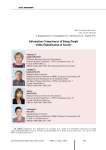Economic and Social Changes: Facts, Trends, Forecast @volnc-esc-en
Статьи журнала - Economic and Social Changes: Facts, Trends, Forecast
Все статьи: 1728
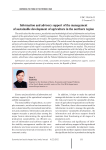
Статья научная
The article describes the essence, peculiarities and methodological basis of information and advisory support of the agricultural sector's stability management. The principles and forms of information and advisory support organization are revealed. The experience of providing advisory services to agriculture in pre-revolutionary Russia and abroad is generalized. The article reveals the regional peculiarities of advisory service formation in the agrarian sector of the Republic of Komi. The main trends of information and advisory support of the region's sustainable agricultural development are studied. The practical recommendations concerning the innovative solutions implementation with the help of the advisory service are given in the article. It also describes the system of advisory support of organizations which includes the republican information and advisory centre (IAC), interregional information and advisory centres, which have close cooperation with the Federal information and advisory service.
Бесплатно

Informational system of monitoring of the region's scientific and technical potential
Статья научная
In the article the characteristics of the modern state of the problem of informational monitoring systems' development are represented, the primary goals of information technologies' application to monitoring scientific and technical potential are formulated. On the analysis' basis the functional system model is based, the mechanism of its basic modules' work is represented. The problems of the program's developing and realizing of the informational system for the regional scientific and technical potential's monitoring are considered. The information system is represented as the programming-informational complex based on the principle of the united information space and providing the operative analytical account and the control of the development parameters of the scientific and technical potential.
Бесплатно
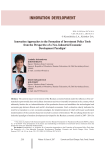
Статья научная
The current macro-environment of the Russian economy formed under the influence of its raw-materials export model does not facilitate investment activity or intensify investment in the country, which ultimately hinders the re-industrialization of the productive forces and establishes the technological and economic gap between Russia and world's developed economies. Such a situation clearly indicates the need for a transition to a new economic paradigm, the implementation of which will ensure accelerated modernization of the economy based on innovative content of investment. We are talking about the neo-industrial paradigm of modern development developed by the Russian economic school in 2007-2014. In this regard, the purpose for the study is to develop the theory and methodology of formation of investment of a new - innovative - type, adequate to the neo-industrial economic paradigm; to identify the factors deterring innovative accumulation of investment in modern Russia; to develop proposals aimed at stimulating investment and innovation activity of business entities of the national economy given the subordination of the country's resource and economic potential to the future neo-industrial development...
Бесплатно
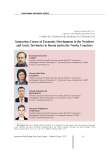
Статья научная
The policy of Russia in the Arctic is based on innovation modernization in the interests of national security, development of the smart use of natural resources, conservation of unique arctic ecosystems and local communities. The aim of the present research was to analyze specific features of innovation policy in Northern and Arctic territories of Russia and the Nordic countries. The article presents an original analysis of development of such a policy, which, in our opinion, can be carried out with the help of considering development scenarios of the Arctic zone and challenges of their implementation in the long term, with the help of studying the situation in the Northern territories and countries in national and global innovation activity rankings; with the help of studying approaches to the formation of innovation policy in the Nordic countries, the experience of which could be used by Russian Federation constituent entities that have similar geographical and geopolitical features...
Бесплатно

Статья научная
The article considers the implementation of innovation technologies in dairy livestock breeding as the main factor enhancing the production competitiveness in the conditions of Russia’s accession to the WTO and the establishment of the Customs Union. The article also reviews the capabilities of innovation technologies in achieving the target production indicators on the one hand (enhancement of manageability, cost reduction, improvement of production quality, increase of the period of productive use of cows), and in minimizing the influence of human factor on the final results, on the other hand. The indicators of production and economic efficiency at the innovation farms of the Vologda and Leningrad oblasts have been analysed.
Бесплатно

Innovation development of the construction complex in the region on the basis of cluster approach
Статья научная
The article substantiates the necessity of using cluster approach in the development of the region’s construction complex for increasing its innovation activity. The formation and development of the regional construction clusters can facilitate the formation of innovation system in the construction complex and integration of different types of innovation. Clusters are also an effective mechanism under the conditions of the market economy; they can unite independent organizations for achieving common strategic goals. Taking the construction cluster of the Ural as an example, the authors discuss the opportunities of using its potential for different purposes, including for the investment development of the Arctic territories. The article shows that cluster can provide innovation-inactive Northern territories with complex innovation construction solutions.
Бесплатно
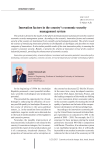
Innovation factors in the country's economic security management system
Статья научная
This article is devoted to the studies in the sphere of introducing innovation factors into the country’s economic security management system. According to the research, innovation factors and economic security of the country are determined by its scientific and technological potential. The article reveals the essence of introducing innovation priorities in the Republic of Azerbaijan and describes two main categories of innovations. It also studies possible results of the state innovation policy in ensuring the country’s economic security. Besides, it presents the scheme of innovation revival of the country’s industrial potential, providing the enhancement of economic security.
Бесплатно
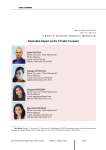
Innovation impact on the circular economy
Статья научная
The paper presents the arguments and counterarguments used in the scientific discussion on the issue of how innovations affect the circular economy and whether it changes accordingly. The main purpose is to analyze the extent to which EU member states manage to boost the circular economy through investment and employment. Review of literary sources and approaches for solving the problem of the multilateral and two-way impact of innovation on the circular economy indicates that the green economy could not exist without the development of innovation, but on the other hand they are its engine. Environmental practices show that there is a need to develop new business models taking into account functionally related innovative changes. The research methods and methodology covers the period from 2008 to 2018. The paper presents the results of an empirical analysis examining the extent to which EU member states manage to boost the circular economy through investment and employment, which showed that measures to increase their economic activity should be in line with the policy of attracting of investment in the circular economy. The research empirically confirms and proves that there still exist certain problems hindering the full implementation of the circular economy; and they are due to the consciousness of the population and employment opportunities in these areas, despite the efforts of the responsible institutions. The results of the research can be useful for public institutions dealing with the circular economy, as well as for the business sector.
Бесплатно
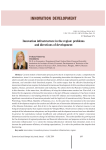
Innovation infrastructure in the region: problems and directions of development
Статья научная
Current models of innovation process prove that it is important to create a comprehensive infrastructure, since it is a necessary condition for promoting innovation development in the area. The article considers the concept of innovation infrastructure, defines its major subsystems and their constituent elements, and considers their functional purpose. The author argues that the effective functioning of innovation infrastructure requires the balanced formation and development of all its constituent subsystems: logistics, finance, personnel, information and marketing. The article shows that Russia is working actively in this direction. At the same time, the efficiency of using the infrastructure remains low. First of all, it is limited by the stagnation of demand for innovation on the part of Russian companies. It has been revealed that the infrastructure is developing primarily in those RF subjects and municipalities, which have the significant concentration of innovation potential and the high level of innovation activity (Moscow, Saint Petersburg, Tomsk Oblast, Republic of Tatarstan, etc.)...
Бесплатно
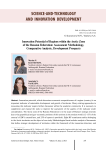
Статья научная
Innovation potential, which determines economic competitiveness of a region (country) is an important indicator of sustainable development and growth of territories. Many existing approaches to measuring this indicator require further discussion within the academic community. It is necessary to supplement and expand the tools to improve the assessment of the quality of the indicator under consideration. The Arctic zone of the Russian Federation is in the scope of Russia’s strategic interests due to the geopolitical and geo-economic positions of this territory in the modern world (12-15% of the country’s GDP is created here, and 25% of exports is provided). Eight RF constituent entities belonging to the Arctic territories are the object of our study. Methodological basis includes analysis of documents that define strategic development of territories within the framework of the innovation direction, and review of existing approaches to assessing innovation potential level. Regional statistical data serve as the information base. The aim of the research is to develop a methodology for assessing innovation potential using objective indicators grouped into blocks and calculated using the integral method. The results are visualized on a radar chart that contains indicators for the regions included in the RF Arctic zone. This makes it possible to compare RF constituent entities according to the degree of innovation potential and determine their position. We suggest clustering regions, identifying leaders and outsiders so as to substantiate proposals to stimulate key areas in innovation activity. We provide an interpretation of the values of innovation potential level. The findings of the research indicate the necessity to design programs for regional development of territories with the involvement of large business as a potential investor.
Бесплатно
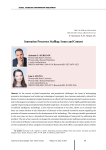
Innovation processes staffing: Issues and content
Статья научная
In the context of global competition and geopolitical challenges, the issues of outstripping innovative development and achieving technological sovereignty have become particularly relevant for Russia. Innovative development largely depends on an effectively functioning national innovation system, and technological sovereignty is ensured not by innovations themselves, but by highly qualified specialists capable of generating and implementing breakthrough ideas. An analysis of the trends in the development of artificial intelligence technology, a most relevant innovation of our time, allows us to conclude that there are certain barriers in the interaction of elements of the national innovation system regarding the provision of human resources for the development of this technology. The existing scientific groundwork in this area does not have a formalized theoretical and methodological framework for addressing this problem. The aim of our research is to design the conceptual foundations for staffing innovation processes in the context of Russia’s national innovation system. Based on the consideration of various points of view on the interpretation of key categories of innovation theory, the article offers a conceptual scheme of their relationship; we formulate our own definition of innovation processes staffing and disclose its content within the framework of Russia’s national innovation system. Using the example of artificial intelligence as one of the key innovations, we identify categories of human resources necessary for various stages of the innovation process. Based on the findings of the study, we propose a comprehensive scheme for staffing the innovation process in the context of the Russian national innovation system, where, together with its traditional elements (business; universities and academic structures; the state), society is considered as an important component of staffing innovation development. Taken together, the results obtained make it possible to formalize innovation processes staffing as a scientific category and define the general outline of this process, which needs further elaboration and development.
Бесплатно
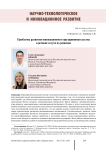
Innovative entrepreneurship development in the region: challenges and ways to address them
Статья научная
The entrepreneurship sector in a market economy is becoming a major driving force of innovative development. This is due to the fact that in a competitive environment, in order to maximize profit growth, an entrepreneur is forced to produce a more complex and innovative product. Thus, entrepreneurship is an “accelerator” of innovation activity. In this regard, special attention has recently been paid to the activities of innovative entrepreneurship. Research findings allowed us to conclude that at the moment there are a number of issues that hinder the development of innovative organizations. Accordingly, the presence of such challenges impedes innovative economic development. It is especially important to identify these problems at the present time, when innovation has become one of the main national priorities. The aim of the work is to identify problems in innovative entrepreneurship development at the regional level and find ways to solve them. The research methodology involves using various scientific techniques: from general scientific to narrow ones. Special attention is paid to economic sociology methods (expert survey). Scientific novelty of the research consists in the development of tools that help to identify problems in the development of innovative organizations at the regional level. Practical significance lies in the fact that on the basis of the challenges identified, we propose directions to address them, which can be adopted by representatives of regional authorities in order to improve the innovation policy pursued in the region.
Бесплатно

Input-output modeling of economic development in the region
Статья научная
In the interests of strategic planning it is necessary to design and develop scientifically substantiated forecasting and analytical tools, including those used to carry out variant calculations of the consequences of management decisions and regional economic policy measures; this determines the relevance of our study, as well as its applied significance. The aim of the research is to model the trajectories of the region's economic development (in the case of the Vologda Region) for the medium term with the help of input-output tables. Tasks: to substantiate the choice of model tools for making forecasts, to develop an input-output model based on calculated regional input-output tables, to identify and substantiate forecast scenarios, as well as to forecast the trajectories of the region's economic development in the medium term as a demonstration of the capabilities of the model toolkit. The article presents the results of scenario forecasting in relation to the trajectories of the economy of the Vologda Region as a model region for the medium term under the influence of various structural policy instruments. We use our own recursive input- output model of the regional economy as a key forecasting tool, which makes up its scientific novelty. Within the framework of three forecast scenarios (inertial, adaptive and transformational), we determine the average annual rate of change in the main indicators of regional development (gross regional product, gross output, investments in fixed assets and net exports) in the medium term, as well as the industry (sectoral) parameters of the Vologda Region's economic structure as of the end of the forecast period. The results obtained in the course of the study are in line with macroeconomic forecasts for development of the national and regional economies in the short and medium term.
Бесплатно







